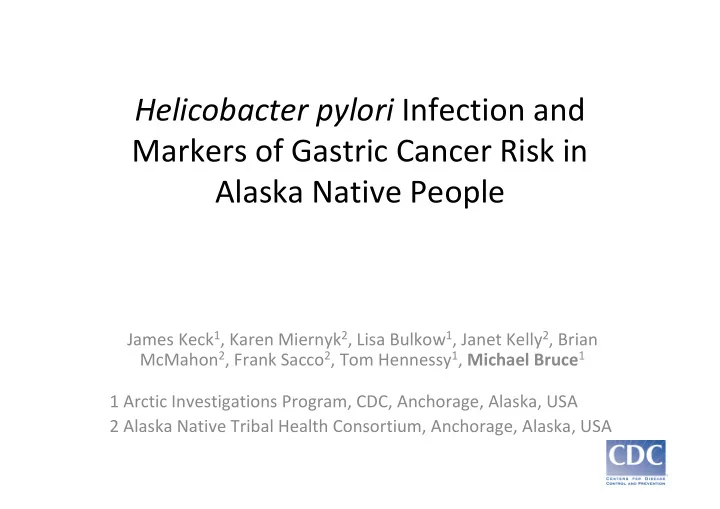

Helicobacter pylori Infection and Markers of Gastric Cancer Risk in Alaska Native People James Keck 1 , Karen Miernyk 2 , Lisa Bulkow 1 , Janet Kelly 2 , Brian McMahon 2 , Frank Sacco 2 , Tom Hennessy 1 , Michael Bruce 1 1 Arctic Investigations Program, CDC, Anchorage, Alaska, USA 2 Alaska Native Tribal Health Consortium, Anchorage, Alaska, USA
Gastric Cancer Background • Cancer is the leading cause of death for Alaska Native people (AN) • Gastric cancer is the 5 th most frequently diagnosed cancer in Alaska Native people – Incidence 4 times that of white US population • Mortality rate 3 times higher than U.S. population
Gastric Cancer & H. pylori in AN Gastric Cancer Mortality (per 100,000) Gastric Cancer incidence (per 100,000) H. pylori seroprevalence Alaska Native Persons US White
U.S. Alaska Natives Greenland 100 90 80 70 60 50 Seroprevalence (%) 40 30 20 10 0 0 5 10 15 20 25 30 35 40 45 50 55 >60 Age, years * Parkinson et al., **Bruce et al.
Study Objectives • Determine association between gastric cancer & H. pylori infection (IgG antibodies) among Alaska Native persons • Determine if prevalence of antibody to cytotoxin- associated gene A, presence of pepsinogen I & II, or blood group are risk factors for gastric cancer among AN/AI • Describe gastric cancers in Alaska Native persons
Study Participants • Identified using the Alaska Area Specimen Bank and the Alaska Tumor Registry • Cases: – Alaska Native adults > 18 years of age residing in Alaska – Diagnosed with gastric adenocarcinoma between 1969 and 2008 – At least 1 serum specimen drawn prior to cancer diagnosis in the Alaska Area Specimen Bank • Controls: – Alaska Native adults > 18 years of age residing in Alaska – Without gastric adenocarcinoma – At least 1 serum specimen in the Alaska Area Specimen Bank collected during the time period 1969-2008
Design • 3 controls matched to each case by: – Region of residence in Alaska – Age group – Sex – Date of serum specimen collection
Study Design • Type: Retrospective case-control study • Time period: 1969-2008 • Five rural Alaska regions participated
Laboratory Testing • Anti- H. pylori antibody ( Helicobacter pylori IgG ELISA; Biohit) • Anti-CagA antibody ( Helicobacter pylori p120 (CagA) ELISA; ravo Diagnostika) • Pepsinogen I & II (ELISA, Biohit) • Blood grouping (Affirmagen pooled reagent red blood cells) • We used the manufacturer’s cut offs for normal versus abnormal levels of pepsinogen I (25 µg/L) and the pepsinogen I/II ratio (2.5).
Results Descriptive Epidemiology Case Control (N=122) (N=346) N (%) N (%) Male 89 (73%) 252 (72.8%) Region of Residence Northwest 28 (23%) 78 (22.5%) Southeast 8 (6.6%) 20 (5.8%) Southwest 59 (48.4%) 172 (49.7%) West 27 (22.1%) 76 (22.0%) Mean age at specimen collection, years 45 (16%) 41 (17%) Mean specimen collection time prior to 13 NA diagnosis, years Mean age at gastric cancer diagnosis, years 59 NA
Results: Univariate Analysis Case (N=122) Control (N=346) N Percent N Percent OR p H. pylori IgG + 112 91.8 285 82.4 2.59 0.01 CagA + 116 95.1 322 93.1 1.40 0.47 H. pylori or Caga + 122 100.0 342 98.8 Pepsinogen I <25 ug/L 5 4.1 7 2.1 1.97 0.27 Pepsinogen I/II < 2.5 6 5.0 10 2.9 1.72 0.33 Blood Group A (referent) 51 41.8 136 39.3 AB 8 6.6 34 9.8 0.64 0.29 B 12 9.8 42 12.1 0.79 0.53 O 51 41.8 134 38.7 1.01 0.98
Results: Non-Cardia Gastric Cancer Cases (N = 94) Univariate analysis OR p H Pylori IgG + 3.49 0.01 CagA + 1.10 0.84 Pepsinogen I low 3.48 0.11 Pepsinogen I/II low 2.30 0.25 Blood group (A referent) AB 0.69 0.45 B 0.72 0.43 O 0.96 0.88 Multivariate analysis H Pylori IgG + 4.1 .003 Pepsinogen I low 6.1 .04 Keck et al. In Press
Results: Non-Cardia Gastric Cancer Cases (N = 94) Univariate analysis OR p H Pylori IgG + 3.49 0.01 CagA + 1.10 0.84 Pepsinogen I low 3.48 0.11 Pepsinogen I/II low 2.30 0.25 Blood group (A referent) AB 0.69 0.45 B 0.72 0.43 O 0.96 0.88 Multivariate analysis H Pylori IgG + 4.1 .003 Pepsinogen I low 6.1 .04 Keck et al. In Press
Descriptive Analysis of Gastric Cancers N = 122 % Histology Adenocarcinoma, NOS 81 66.4 Linitis plastica 4 3.3 Adenocarcinoma, intestinal type 8 6.6 Adenocarcinoma, diffuse type 3 2.5 Tubular adenocarcinoma 1 0.8 Papillary adenocarcinoma 2 1.6 Mucinous adenocarcinoma 3 2.5 Mucin-producing adenocarcinoma 1 0.8 Signet ring cell adenocarcinoma 19 15.6 Histologic grade N = 98 Well Differentiated 6 6.1 Moderately Differentiated 35 35.7 Poorly Differentiated 55 56.1 Undifferentiated 2 2.0 14
Gastric Cancer Location Cancer site N = 122 % Cardia, NOS 28 23.0 Fundus 7 5.7 Antrum 19 15.6 Pyloris 6 4.9 Lesser curvature 30 24.6 Greater Curvature 13 10.7 Overlapping 4 3.3 Stomach, NOS 15 12.3 15
Conclusions • Exposure to H. pylori in our study population was very high • Previous H. pylori infection associated with gastric cancer in AN • For non-cardia cases, low pepsinogen I also a risk factor • Exposure to CagA virulence gene not associated with gastric cancer in our study
Goals / Challenges • Lay ground work for a larger scale prospective study that includes tissue collection looking at gastric cancer and H. pylori infection in Alaska Native people – Bacterial virulence factors – Host genetic predisposition – Environmental co-factors
Acknowledgements • Staff at the Arctic Investigations Program
Recommend
More recommend